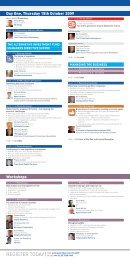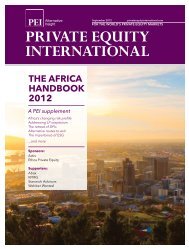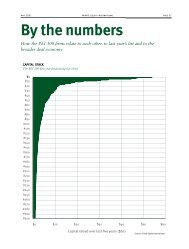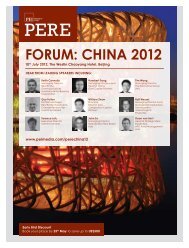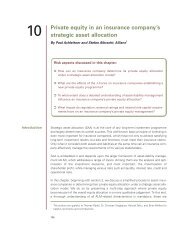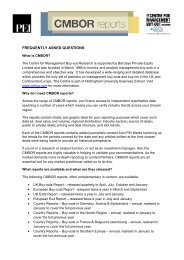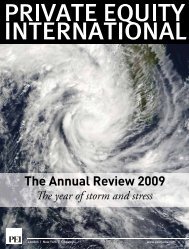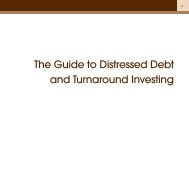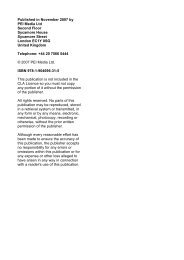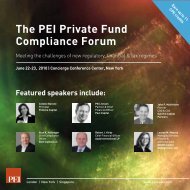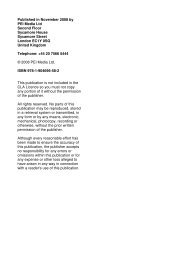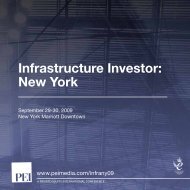THE ANNUAL REVIEW 2010 - PEI Media
THE ANNUAL REVIEW 2010 - PEI Media
THE ANNUAL REVIEW 2010 - PEI Media
Create successful ePaper yourself
Turn your PDF publications into a flip-book with our unique Google optimized e-Paper software.
page 66 private equity annual review <strong>2010</strong><br />
together is they all count Temasek Holdings as an investor.<br />
The smaller of Singapore’s two sovereign wealth funds, Temasek<br />
is also a frequent co-investor with its private equity partners (see<br />
the following category).<br />
The S$186 billion (€107 billion; $145 billion) Temasek<br />
rebounded in <strong>2010</strong> from a dismal fiscal 2008/09, when its<br />
portfolio value had hit a low of S$130 billion. That brought it<br />
back in line with pre-crisis valuations.<br />
Temasek has recorded 17 percent compound annual returns<br />
by market value since inception in 1974, and 42 percent in the<br />
12 months through June <strong>2010</strong>. Temasek executive director Simon<br />
Israel said in a press conference at the time that a significantly<br />
higher level of returns had been recorded by investments made<br />
after 31 March 2002, when Temasek shifted its investment strategy<br />
to incorporate a greater focus on Asia and reduce exposure to the<br />
mature economies of the OECD.<br />
Direct/co-INVESTOR of <strong>THE</strong> YEAR<br />
1. Temasek Holdings<br />
2. China Investment Corp.<br />
3. Partners Group<br />
In line with a trend taking place<br />
around the globe, large asset<br />
owners in Asia, like pension<br />
and sovereign wealth funds,<br />
are increasingly interested in<br />
making direct investments or<br />
co-investing alongside private<br />
equity firms with attractive<br />
Temasek: Going directly to the<br />
source<br />
terms (usually paying no GP fees or carry).<br />
Temasek’s name pops up frequently on direct deals, often in<br />
partnership with GPs like Hopu Investment Management, run by<br />
former Goldman Sachs China partner Fang Fenglei. Prominent<br />
<strong>2010</strong> investments of this kind include the pair’s $600 million share<br />
purchase into North American oil and gas developer Chesapeake<br />
Energy, as well as a $200 million investment in China’s largest<br />
orange plantation, Asian Citrus Holdings.<br />
Responsible INVESTOR of <strong>THE</strong> YEAR<br />
1. Squadron Capital<br />
2. CDC Group<br />
3. The Government Superannuation Fund Authority<br />
of New Zealand<br />
Taking home PE Asia’s inaugural responsible investor award is Hong<br />
Kong-based fund of funds Squadron Capital, a firm notable for being<br />
an early mover – amongst Asia-based investors at least – for signing up<br />
to the UN Principles for Responsible Investment, which it did in 2009.<br />
The PRI gives firms a framework and process for implementing responsible<br />
investment practices throughout the life cycle of an investment.<br />
Alice Chow, managing director at the<br />
firm, said shortly after Squadron signed<br />
up to the Principles that influencing<br />
environmental, social and governance<br />
issues at Asian portfolio companies can<br />
be difficult since most GPs own minority<br />
positions. “You don’t have majority control<br />
of the board and you don’t have majority<br />
Chow: An early control of the management of the company.<br />
signatory to the You’re really relying on your judgement of<br />
UN PRI<br />
the management team that they are honest,<br />
do their job with integrity and follow the rules,” she said.<br />
Large deal of <strong>THE</strong> YEAR [$500m+]<br />
1. Healthscope – TPG, Carlyle Group<br />
2. Dili Group – The Blackstone Group, Warburg<br />
Pincus, Atlantis Investment Management Capital<br />
3. Matahari – CVC Asia Pacific<br />
Not only was the $2.3 billion acquisition in<br />
July of hospital chain Healthscope by The<br />
Carlyle Group and TPG Capital the largest<br />
buyout seen in Australia for two years, it was<br />
also an example of private equity firms returning<br />
to doing what private equity firms do best:<br />
“buying companies no one else wants”, as one<br />
GP put it. The company was perceived to<br />
be under-valued on the stock exchange, and<br />
though there was one strategic buyer in the<br />
mix, the pricing battle primarily centered on<br />
rivalry between two competing private equity consortia.<br />
Others pointed to the Healthscope take-private as a sign that<br />
fears foreign private equity firms would avoid investment in<br />
Australia due to uncertainty around the tax treatment of offshore<br />
holding companies in deal structures were unfounded. That TPG<br />
itself – the firm whose exit from Myer Group prompted the<br />
Australian Taxation Office to revise its private equity policies –<br />
was back in the fray suggested, said one professional, that the firm<br />
was confident it had found a way to navigate the uncertainty. The<br />
Healthscope deal had also attracted interest from CVC Asia Pacific,<br />
The Blackstone Group and Kohlberg Kravis Roberts.<br />
Large exit of <strong>THE</strong> YEAR<br />
1. Shenzhen Development Bank – TPG<br />
2. Parkway Holdings – TPG<br />
3. Study Group – CHAMP Private Equity<br />
TPG, Carlyle: Had<br />
their fingers on the<br />
pulse with Healthscope<br />
The financial services sector in Asia has been notoriously tricky<br />
to transact in, but the exit of Shenzhen Development Bank<br />
(SDB) by TPG Capital proved that if you were prepared to tackle a<br />
mountain of uncertainty, you may just reap a mountain of returns.



